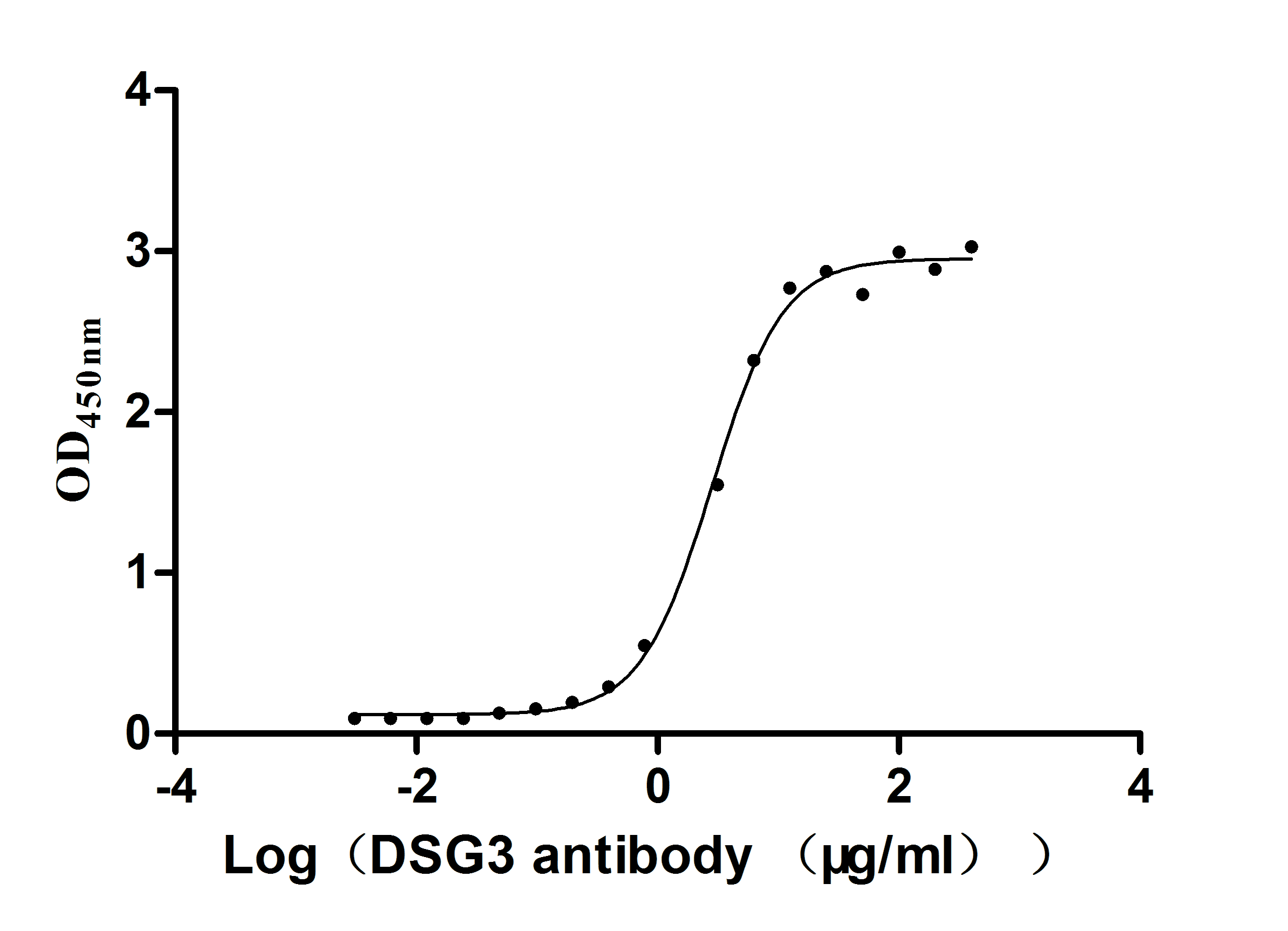Recombinant Simian hepatitis A virus genotype IV Genome polyprotein, partial
-
中文名称:Recombinant Simian hepatitis A virus genotype IV Genome polyprotein ,partial
-
货号:CSB-YP333638SGR
-
规格:
-
来源:Yeast
-
其他:
-
中文名称:Recombinant Simian hepatitis A virus genotype IV Genome polyprotein ,partial
-
货号:CSB-EP333638SGR
-
规格:
-
来源:E.coli
-
其他:
-
中文名称:Recombinant Simian hepatitis A virus genotype IV Genome polyprotein ,partial
-
货号:CSB-EP333638SGR-B
-
规格:
-
来源:E.coli
-
共轭:Avi-tag Biotinylated
E. coli biotin ligase (BirA) is highly specific in covalently attaching biotin to the 15 amino acid AviTag peptide. This recombinant protein was biotinylated in vivo by AviTag-BirA technology, which method is BriA catalyzes amide linkage between the biotin and the specific lysine of the AviTag.
-
其他:
-
中文名称:Recombinant Simian hepatitis A virus genotype IV Genome polyprotein ,partial
-
货号:CSB-BP333638SGR
-
规格:
-
来源:Baculovirus
-
其他:
-
中文名称:Recombinant Simian hepatitis A virus genotype IV Genome polyprotein ,partial
-
货号:CSB-MP333638SGR
-
规格:
-
来源:Mammalian cell
-
其他:
产品详情
-
纯度:>85% (SDS-PAGE)
-
基因名:N/A
-
Uniprot No.:
-
别名:Genome polyprotein [Cleaved into: Protein VP0; VP4-VP2); Protein VP4; P1A; Virion protein 4); Capsid protein VP2; P1B; Virion protein 2); Capsid protein VP3; P1C; Virion protein 3); Protein VP1-2A; VPX); Capsid protein VP1; P1D; Virion protein 1); Assembly signal 2A; pX); Protein 2BC; Protein 2B; P2B)]; Fragment
-
种属:Simian hepatitis A virus genotype IV (isolate CY-145) (SHAV) (Simian hepatitis A virus (isolate Macaca/Philippines/CY-145/1988))
-
蛋白长度:Partial
-
蛋白标签:Tag type will be determined during the manufacturing process.
The tag type will be determined during production process. If you have specified tag type, please tell us and we will develop the specified tag preferentially. -
产品提供形式:Lyophilized powder
Note: We will preferentially ship the format that we have in stock, however, if you have any special requirement for the format, please remark your requirement when placing the order, we will prepare according to your demand. -
复溶:We recommend that this vial be briefly centrifuged prior to opening to bring the contents to the bottom. Please reconstitute protein in deionized sterile water to a concentration of 0.1-1.0 mg/mL.We recommend to add 5-50% of glycerol (final concentration) and aliquot for long-term storage at -20℃/-80℃. Our default final concentration of glycerol is 50%. Customers could use it as reference.
-
储存条件:Store at -20°C/-80°C upon receipt, aliquoting is necessary for mutiple use. Avoid repeated freeze-thaw cycles.
-
保质期:The shelf life is related to many factors, storage state, buffer ingredients, storage temperature and the stability of the protein itself.
Generally, the shelf life of liquid form is 6 months at -20°C/-80°C. The shelf life of lyophilized form is 12 months at -20°C/-80°C. -
货期:Delivery time may differ from different purchasing way or location, please kindly consult your local distributors for specific delivery time.Note: All of our proteins are default shipped with normal blue ice packs, if you request to ship with dry ice, please communicate with us in advance and extra fees will be charged.
-
注意事项:Repeated freezing and thawing is not recommended. Store working aliquots at 4°C for up to one week.
-
Datasheet :Please contact us to get it.
靶点详情
-
功能:Capsid proteins VP1, VP2, and VP3 form a closed capsid enclosing the viral positive strand RNA genome. All these proteins contain a beta-sheet structure called beta-barrel jelly roll. Together they form an icosahedral capsid (T=3) composed of 60 copies of each VP1, VP2, and VP3, with a diameter of approximately 300 Angstroms. VP1 is situated at the 12 fivefold axes, whereas VP2 and VP3 are located at the quasi-sixfold axes. The naked capsid interacts with the host receptor HAVCR1 to provide virion attachment to and probably entry into the target cell.; Capsid proteins VP1, VP2, and VP3 form a closed capsid enclosing the viral positive strand RNA genome. All these proteins contain a beta-sheet structure called beta-barrel jelly roll. Together they form an icosahedral capsid (T=3) composed of 60 copies of each VP1, VP2, and VP3, with a diameter of approximately 300 Angstroms. VP1 is situated at the 12 fivefold axes, whereas VP2 and VP3 are located at the quasi-sixfold axes. The naked capsid interacts with the host receptor HAVCR1 to provide virion attachment to and probably entry into the target cell.; Capsid proteins VP1, VP2, and VP3 form a closed capsid enclosing the viral positive strand RNA genome. All these proteins contain a beta-sheet structure called beta-barrel jelly roll. Together they form an icosahedral capsid (T=3) composed of 60 copies of each VP1, VP2, and VP3, with a diameter of approximately 300 Angstroms. VP1 is situated at the 12 fivefold axes, whereas VP2 and VP3 are located at the quasi-sixfold axes. The naked capsid interacts with the host receptor HAVCR1 to provide virion attachment to and probably entry into the target cell.; VP0 precursor is a component of the immature procapsids.; Plays a role in the assembly of the 12 pentamers into an icosahedral structure. Has not been detected in mature virions, supposedly owing to its small size.; Precursor component of immature procapsids that corresponds to an extended form of the structural protein VP1. After maturation, possibly by the host Cathepsin L, the assembly signal 2A is cleaved to give rise to the mature VP1 protein.; Affects membrane integrity and causes an increase in membrane permeability.; Functions as a viroporin. Affects membrane integrity and causes an increase in membrane permeability. Involved in host intracellular membrane rearrangements probably to give rise to the viral factories. Does not disrupt calcium homeostasis or glycoprotein trafficking. Antagonizes the innate immune response of the host by suppressing IFN-beta synthesis, which it achieves by interfering with the DDX58/IFIH1 (RIG-I/MDA5) pathway.
-
亚细胞定位:[Capsid protein VP2]: Virion. Host endosome, host multivesicular body.; [Capsid protein VP3]: Virion. Host endosome, host multivesicular body.; [Capsid protein VP1]: Virion. Host endosome, host multivesicular body.; [Capsid protein VP4]: Virion.; [Protein 2B]: Host membrane; Peripheral membrane protein.
-
蛋白家族:Picornaviridae polyprotein family
Most popular with customers
-
Recombinant Mouse Desmoglein-3 (Dsg3), partial (Active)
Express system: Mammalian cell
Species: Mus musculus (Mouse)












